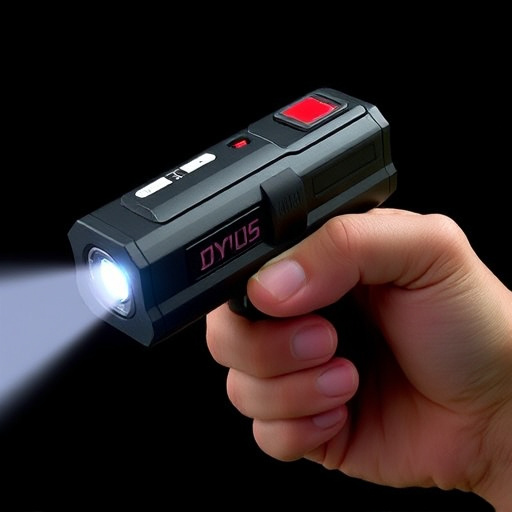Smart Phone Stun Guns deliver electric currents that disrupt the nervous system, temporarily incapacitating targets (3-5 minutes) with varying effectiveness based on voltage, pulse width, current intensity, target's health, and environmental conditions. While non-lethal, they require responsible use & training due to potential risks of muscle incapacitation. Their compact size makes them popular, but understanding their temporary impact is crucial for effective self-defense.
“Unraveling the complexities of muscle incapacitation from stun guns is crucial for understanding their effectiveness and potential risks. This comprehensive guide explores the duration of muscle paralysis, delving into the science behind stun gun design and its impact on recovery times.
From traditional models to innovative smart phone stun guns, we debunk myths and reveal real-world effects. Learn how design features influence incapacitation durations and discover factors that speed up recovery after an incident involving these devices.”
- Understanding Muscle Incapacitation: What Happens When Stun Guns Strike
- The Role of Stun Gun Design: Features Affecting Duration of Inability
- Factors Influencing Recovery Time After a Stun Gun Incident
- Smart Phone Stun Guns: Debunking Myths and Uncovering Real-World Effects
Understanding Muscle Incapacitation: What Happens When Stun Guns Strike

When a stun gun, including those designed for personal defense and sometimes found in smartphones, makes contact with a target, it delivers an electric current that disrupts the nervous system. This disruption causes immediate muscle contraction and subsequent incapacitation. The duration of this muscle incapacitation is a key factor in assessing the effectiveness of a stun gun, especially in self-defense situations.
The length of time a person remains incapacitated can vary based on several factors, including the stun gun’s voltage output, the area targeted, and the individual’s overall health and tolerance to pain. Smart phone stun guns, with their lower voltage settings, are designed for non-lethal self-defense, aiming to disable an assailant long enough for the victim to escape or gain help. However, it’s important to remember that even a brief period of muscle incapacitation can be dangerous in the wrong hands, emphasizing the need for responsible use and training.
The Role of Stun Gun Design: Features Affecting Duration of Inability

The design and features of a stun gun play a significant role in determining the duration of muscle incapacitation it inflicts. Modern stun guns, often incorporated into devices like smart phone stun guns, employ advanced technology to disrupt muscular control. These gadgets typically utilize electric current to overwhelm the body’s natural electrical signals, leading to temporary paralysis. The duration of this incapacitation depends on several factors within the device’s design: voltage output, pulse width, and current intensity.
Higher voltage outputs generally result in faster and more intense shocks, potentially reducing the time a target remains immobilized. Pulse width refers to the length of each electric pulse, with shorter pulses often leading to quicker recovery. Current intensity, the force behind the shock, also impacts duration; stronger currents can prolong the period of muscle weakness. Thus, stun gun manufacturers must balance these components to achieve an effective yet safe duration of incapacitation, ensuring users have a powerful tool while adhering to safety guidelines.
Factors Influencing Recovery Time After a Stun Gun Incident

After a stun gun incident, the recovery time for muscle incapacitation can vary significantly based on several factors. Age and overall physical condition are key considerations; younger, healthier individuals tend to recover faster due to their bodies’ enhanced ability to heal and respond to trauma. The duration of the stun and its intensity also play a crucial role; longer or more powerful shocks can lead to prolonged muscle weakness and discomfort.
Other factors include any pre-existing medical conditions that might affect healing, such as diabetes or cardiovascular issues. Environmental factors like temperature and humidity can influence recovery, with hotter environments potentially exacerbating discomfort. Additionally, the use of a Smart Phone Stun Gun introduces technological variables; its design, battery life, and the specific electric current it delivers can all contribute to the post-incident recovery duration and experience.
Smart Phone Stun Guns: Debunking Myths and Uncovering Real-World Effects

Smart Phone Stun Guns have gained popularity due to their compact size and perceived ease of use, often advertised as a quick defense mechanism. However, the effectiveness and duration of muscle incapacitation remain subjects of debate. It’s crucial to understand that while these devices can deliver a powerful shock, the results are not always as dramatic or prolonged as some marketing claims suggest.
In reality, the impact on an assailant is temporary, with studies indicating that the average stun gun leaves them incapacitated for 3-5 minutes. This period varies based on factors like the device’s voltage and the target’s physical condition. Despite popular belief, a stun gun doesn’t always cause immediate muscle paralysis or permanent damage. Instead, it disrupts nerve signals, leading to temporary weakness and disorientation. Debunking myths surrounding Smart Phone Stun Guns is essential for users to have realistic expectations of their capabilities in real-world situations.
The study of muscle incapacitation from stun guns reveals a complex interplay between technology, biology, and individual factors. As we’ve explored, understanding the duration of incapacitation is crucial for both public safety and personal defense. Key aspects, such as stun gun design and recovery time variables, play significant roles in determining the overall impact. Furthermore, emerging trends like smart phone stun guns necessitate continued research to ensure their effectiveness and mitigate potential risks. By delving into these areas, we can enhance our knowledge and improve strategies related to these powerful tools.
